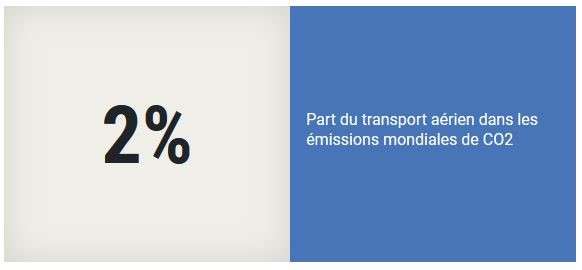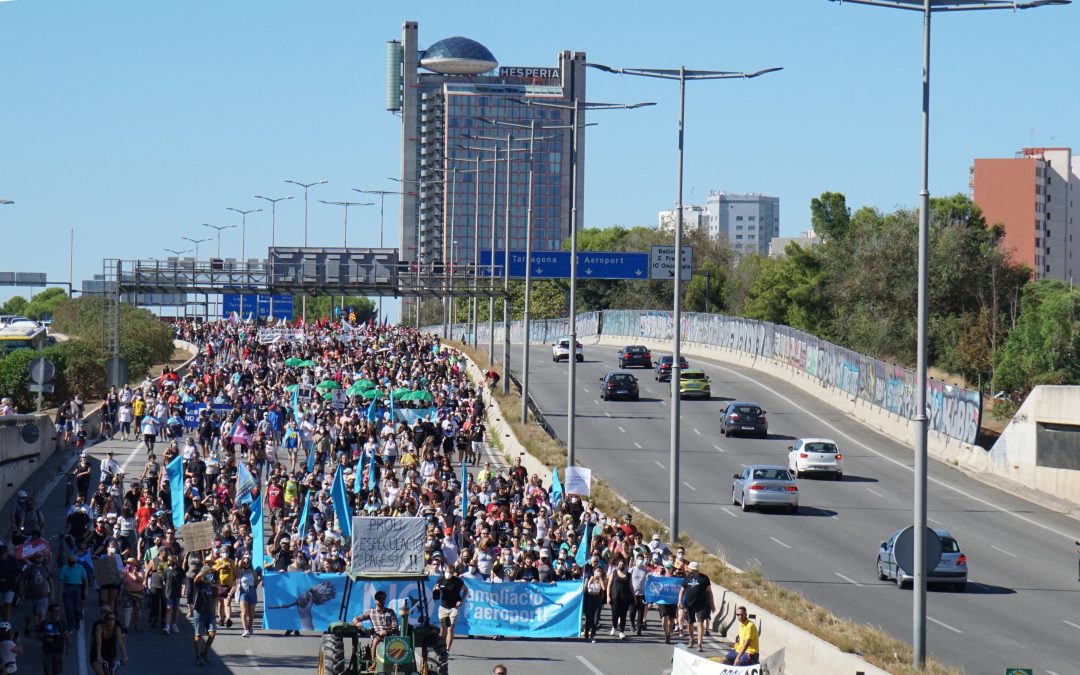By repeating that aviation’s CO2 emissions are only 2% of total emissions, the aviation sector has succeeded in conveying the idea that its impact is low and that people can continue to fly despite the lack of credible decarbonisation solutions. This figure, abundantly taken up by the press and politicians, is not false in itself [1], but aims to manipulate us. We explain why and how.
► By putting things into perspective
‘Aviation is just 2%’.
2% may not seem like much, but it is more than most countries! If aviation were a country, it would rank 6th between Japan and Germany, well ahead of France, which accounts for only 1% of global emissions [2]. Would we accept that a country does nothing on the pretext that its emissions represent only a few percent of global emissions?
► By not counting everything
‘Aviation accounts for only 2% of CO2 emissions’.
The aviation sector only talks about the CO2 emitted during the flight. This is completely incomplete! To this must be added the CO2 emissions linked to the production and distribution of kerosene, which represent about 20% of what is emitted during the flight. But above all, it’s not just CO2! CO2 is responsible for only a third of aviation induced global heating. The aviation sector “forgets” to count the effects of contrails and induced cirrus clouds, as well as the effects of nitrogen oxide (NOx) derivatives (the non-CO2 effects). Adding all this up, we actually arrive at 5.9% of global greenhouse gas emissions [3].
► By giving global figures
‘Aviation accounts for only 2% of global CO2 emissions’
 2% is a global average that puts developed countries like ours, in which a wealthy fringe of the population regularly flies, and poor countries where very few fly, in the same basket. Putting forward this figure, as the Ministry of Ecological Transition is doing in France, amounts to erasing the importance of the climate impact of air transport in developed countries. In France, aviation contributes not 2%, but 6.8% to CO2 emissions [4] and 15% to total greenhouse gas emissions if we include the omitted elements [5]. That’s nearly twice the emissions from residential heating [6]!
2% is a global average that puts developed countries like ours, in which a wealthy fringe of the population regularly flies, and poor countries where very few fly, in the same basket. Putting forward this figure, as the Ministry of Ecological Transition is doing in France, amounts to erasing the importance of the climate impact of air transport in developed countries. In France, aviation contributes not 2%, but 6.8% to CO2 emissions [4] and 15% to total greenhouse gas emissions if we include the omitted elements [5]. That’s nearly twice the emissions from residential heating [6]!
► By ignoring the growing share of its emissions
‘Today, aviation accounts for only 2% of global CO2 emissions’
Not only do aviation emissions constitute a significant part of French CO2 emissions, but this share is growing steadily and is expected to continue to grow. From nearly 5% in 2000, it rose to nearly 7% in 2019 and is expected to rise to 12% in 2030 (for CO2 alone) [7]. The reason is simple: while most other sectors are making significant efforts to reduce their emissions to reach the European target of -55% by 2030 [8], the aviation sector is exempt. It is also opposed to any measures to limit traffic, while none of the decarbonisation solutions envisaged can be implemented within a timeframe and on a scale compatible with the Paris Agreement [9].
How does Stay Grounded gets the figure of 15%
for aviation’s share of France’s total GHG emissions?
In 2019, aviation departing from and arriving at French airports emitted 24.4 Mt CO2 (DGAC/Em, p. 6). To this must be added 21% for upstream emissions, i.e. 5.1 Mt (DGAC/Calc), 1% for in-flight N2O emissions, i.e. 0.2 Mt CO2e, and twice the CO2 emissions for non-CO2 effects, i.e. 48.8 Mt CO2e (Lee et al 2021, see It’s not just CO2). That is a total of 78.6 Mt CO2e.
In 2019, France emitted 443 Mt CO2e of greenhouse gases (Citepa, Table 15). To this must be added emissions from international aviation (18.7 Mt CO2) and maritime (5.5 Mt CO2) bunkers, i.e. the share attributed to France of the consumption of ships and aircraft operating international routes (Citepa, Table 19) and the non-CO2 effects of aviation (48.8 Mt CO2e, see above). That is a total of 516 Mt CO2e.
In 2019, the share of aviation in France’s emissions was therefore 15.2% (= 78.6 / 516)
Data sources:
- DGAC/Em : Direction générale de l’aviation civile, juillet 2023, Les émissions gazeuses liées au trafic aérien en France en 2021
- DGAC/Calc : Direction générale de l’aviation civile, Calculateur d’émissions de gaz à effet de serre de l’aviation
- Citepa : Centre interprofessionnel technique d’études de la pollution atmosphérique, avril 2021, CCNUCC (NIR) – Le rapport d’inventaire officiel dans le cadre de la Convention Climat
CO2e = CO2 equivalent. The CO2 equivalent of the non-CO2 effects of aviation is calculated from their GWP* ( Lee et al. 2021, Abstract)
Notes:
[1] ATAG (Air Transport Action Group), 2020: Aviation: Benefits Beyond Borders. According to ATAG, a coalition of aviation industry organisations and companies, airlines emitted 914 million tonnes of CO2 in 2019, representing 2.1% of global man-made CO2 emissions (p. 13).
[2] Stay Grounded (2022): Common Destination (p. 14)
[3] Stay Grounded, 2022: It’s about more than just CO2
[4] Direction générale de l’aviation civile (DGAC), 2023: Les émissions gazeuses liées au trafic aérien en France en 2021, p. 7.
[5] See infobox
[6] Ministère de la transition écologique, 2020: Les facteurs d’évolution des émissions de CO2 liées à l’énergie en France de 1990 à 2018 (Tab 6 of the accompanying spreadsheet). In 2018, emissions from residential heating in France were 42.4 Mt CO2. That year, CO2e emissions from all air traffic amounted to 75.4 Mt CO2: 23.5 Mt CO2 (DGAC/Em, p. 6) + 4.9 Mt CO2 for upstream emissions + 47 Mt CO2e for the non-CO2 effects.
[7] For 2019, DGAC/Em, p. 7. For 2000, calculated using the DGAC method. Also for 2030, based on the optimistic assumption that CO2 emissions from aviation will remain at their 2019 level (traffic growth offset by improved efficiency and so-called sustainable aviation fuels) and that France’s CO2 emissions will be 55% below 1990 levels.
[8] European Council: Fit for 55
[9] Stay Grounded :



